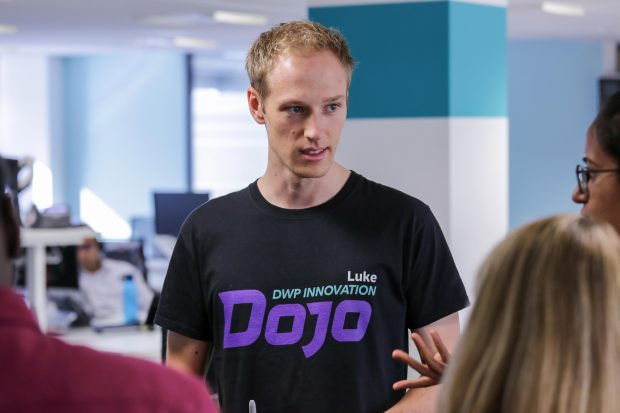
I’m a scrum master in the Innovation Dojo. A typical week is very dynamic and it takes a great deal of forward planning and coordination.
The Innovation Dojo
The Innovation Dojo is a dedicated space within DWP Digital to innovate. Teams working in the dojo facilitate rapid prototyping, initiated via a design thinking approach, to develop conceptual solutions to the departments business problems. Co-creating and collaborating with Accenture, a small diverse team of people work together in the Innovation Dojo on a specific problem or opportunity. Read more about the dojo in our blog-post Finding solutions in our Innovation Dojo.
What does a typical week look like for me?
Task planning for the current sprint
If I had to start somewhere then I’d start with my Wednesday mornings, which begin with the scrum planning sessions for the current sprint.
This is where the team gathers to plan out and estimate the tasks. The team reads through the objective and goals that have been set by the product owner. We then plan the entire sprint using story points. By the end of the planning session, the team will have a final set of stories and associated tasks to work on for the next 5 days.
Retrospectives
Later on in the day we’ll hold a retrospective of the previous sprint to reflect on what went well, what could have gone better and what needs changing to move forward. The retrospective is a chance to openly discuss all aspects of the previous sprint. Usually I try to be creative with the team and come up with different methods to make it fun and engaging such as using emojis or mood graphs. Each retrospective focuses on the sprint outcomes to maximise the opportunities to improve the next sprint or iteration.
I then document the retrospectives on Confluence with all the outcomes and any action points that are raised, ready to be implemented and reviewed in the next session.
Daily stand-ups
Over the next few days, the team will have daily stand ups to discuss the key activities and any blockers to their tasks. My role is in observing and understanding the progress of the sprint and helping with any blockers, this could be putting the team in contact with the right stakeholders or speaking to the maintenance team to resolve issues in the working environment. These few days are usually a good opportunity for the scrum master to prepare for the sprint demo and organise the logistics required for coming sprints.
Preparation is key
Being organised is really important, one of the challenges I have is to coordinate stakeholder diaries, room availability and the sprint cycle. So I book meetings 3 months in advance to get alignment. I also get prepared for the next iteration by creating the Jira/Confluence pages and give the team access, as well as working on ad-hoc deliverable’s such as the delivery roadmap, iteration video, project summary and the team delivery portfolio.
The final sprint stand-up
The final day of the sprint is a Tuesday and the most hectic!
In the morning the team have a final sprint stand-up where I’ll get a good understanding on the end of day position. I say this because the sprint show and tell demo usually occurs before the end of the sprint, so we predict the expected outcome to stakeholders.
By the end of the stand-up I’ll understand from the team who will be presenting to the stakeholders and who will be providing content for the demo presentation. It’s my job to create the presentation deck for the sprint demo. The presentation is a culmination of inputs from the planning session, the team updates during the week and the burn down graphs from Jira. I’ll also speak to each team member to get an overview on their individual sprint outcomes to document in the report.
The show and tell demo
By the time we get to the sprint show and tell demo at 2pm, a sprint report would have been put together and reviewed. I’ll gather the team and we’ll video call any stakeholders not located in our London hub.
During the hour long show and tell session we’ll present to the stakeholders, which would normally include the Chief Technology Officer of the programme and the teams who are invested in the iteration we’ve been working on. Our scrum team will present any spikes or architecture changes as well as a minimal viable product demonstration. It usually ends in a discussion about potential enhancements and areas of interest to consider for the next sprint.
A scrum master’s role never stops, especially when working in weekly sprints. Each day brings new challenges and the opportunity to build unexpected relationships with new people around the organisation. The satisfaction is in knowing that when I’ve done my job well the team are able to deliver week on week.
Next steps
We spend around 8-12 weeks on sprints for the initial business challenge, adopting agile ways of working and a fail-fast mentality, to deliver a working prototype. It’s a starting point for a larger transformation that, in the medium term, will be moved into a project and developed in a technology-led environment.
Find out more by watching this video about our Innovation Dojo. Check out some of the roles we currently have available on our careers website. You can also stay up to date with everything that’s happening on our Twitter channels @DWPDigital and @DWPDigitalJobs, and on LinkedIn.
